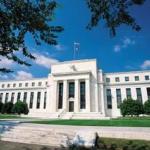 Quantitative easing is set to expire this month. That’s the plan at least. The $10 billion monthly tapers will finally bring the Fed’s QE3 bond buying program down from $85 billion per month to zero.
Quantitative easing is set to expire this month. That’s the plan at least. The $10 billion monthly tapers will finally bring the Fed’s QE3 bond buying program down from $85 billion per month to zero.
That’s not to say the Fed will no longer be operating with extreme monetary policies of market intervention. Remember, the federal funds rate is still at practically zero. This is something that had never happened until the fall of 2008.
Now, six year later, the federal funds rate is still pressed firmly down to the ground. According to Federal Reserve utterances, they won’t begin raising the federal funds rate for another six months. Of course, that could always change depending on what way the wind blows.
The Fed has shown that they are making things up as they go. They are just winging it. Should they raise interest rates? Should they stop expanding the money supply?
The answers to these questions depend on what data point they want to use. For a long time, the Fed was going to exit QE when the unemployment rate dipped below 6.5 percent. Yet when that happened they didn’t follow through on what they said they’d do…they just made up a different approach.
Seeking 2 Percent
These days the Fed’s approach seems to be hyper focused on achieving a 2 percent inflation target. They believe 2 percent inflation is needed in order to best achieve their mandate for price stability and maximum employment. Here at the Economic Prism we disparage this course.
We favor a stable money supply and letting everything else adjust according to market supply and demand. This includes employment, wages, and the price of credit. But our opinion on the matter is beside the point. For the point is, now that QE is set to expire something unexpected is happening. Inflation is dropping; not rising. What should the Fed do?
“After months of focus on slack in U.S. labor markets,” explains Reuters, “the Federal Reserve faces a new challenge: the possibility that weak inflation may be so firmly entrenched it upends the return to normal monetary policy.
“The soft global inflation backdrop, from sliding oil prices to stagnant wages in advanced economies, has triggered debate over whether the Fed and its peers merely need to wait for a slow-motion business cycle to improve, or face a shift in the underlying nature of inflation after the global recession.
“That uncertainty has become the Fed’s chief concern in recent weeks, likely to shape upcoming policy statements and delay even further the moment when interest rates, pinned near zero for nearly six years, will start rising again.”
One Hundred Years of Failure and Counting
On Wednesday, we’ll all find out what the Fed’s latest plan will be. Will they extend QE? When will they raise rates?
These, no doubt, are critical questions. For they affect the price of money. By extension, the price of money affects the price of all goods and services in the economy.
Central planners believe by tinkering with the price of money they can achieve the ideal of “maximum collective welfare.” This is the elusive promise of a scientifically managed economy. Still, one hundred years of failure doesn’t stop the lunkheads from trying.
They demand 2 percent inflation. Then they get to work doing the darnedest things to achieve it. They artificially suppress interest rates. They expand the money supply with reckless abandoned.
Both of these acts are policies of mass inflation. Yet, to their dismay, inflation doesn’t rise. Rather, it falls. The Fed never seems to recognize that the world isn’t a predictive linear graph. It’s complex. Connecting the data dots, and making policy decisions from them, takes you in directions that are entirely at odds with reality.
“To me, a wise and humane policy is occasionally to let inflation rise even when inflation is running above target,” once remarked Fed Chair, Janet Yellen.
Alas, for Yellen, she cannot will it to happen.
Sincerely,
MN Gordon
for Economic Prism
Return from One Hundred Years of Failure and Counting to Economic Prism




